In the diverse realm of flora, tropical houseplants captivate plant enthusiasts with their lush and exotic appeal. Hailing from the world’s rainforests and jungles, these plants not only bring a touch of the tropics to our living spaces but also remind us of nature’s intricate beauty.
To truly thrive, tropical houseplants require a delicate balance of humidity, warmth, and light, mimicking their native habitats. In this guide, we explore the art of creating a humidity-friendly environment for these green gems, delving into methods to increase humidity levels, identifying and addressing humidity-related issues, and revealing secrets to expert tropical plant care.
Join us on this fascinating journey through the world of tropical houseplants and learn how to create a haven for these splendid species within your abode.
Understanding Humidity
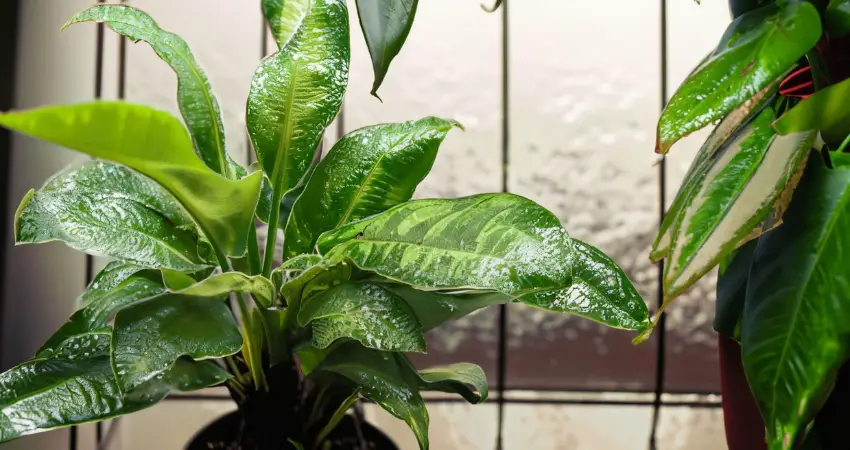
Before we dive into how to create a humidity-friendly environment for your tropical plants, let’s get a grasp on what humidity actually is.
In essence, humidity refers to the amount of water vapor in the air. It plays a significant role in determining the comfort level of any environment, including the health and wellbeing of your plants.
Relative Humidity vs. Absolute Humidity
When it comes to humidity, there are two types you should be aware of:
- Relative humidity (RH): This is the most common measurement and refers to the percentage of moisture in the air compared to the maximum amount it could hold at a given temperature. For example, 50% RH means the air is holding half the moisture it could at that temperature.
- Absolute humidity: This measures the actual amount of moisture in the air, typically expressed in grams per cubic meter (g/m³). Unlike relative humidity, absolute humidity is not affected by temperature.
Ideal Humidity Levels for Tropical Houseplants
Tropical houseplants typically thrive in environments with 60-80% relative humidity. This is significantly higher than the average indoor humidity level, which usually ranges from 30-50%. Thus, creating a humidity-friendly environment for your tropical plants is crucial for their health and growth.
Factors Affecting Indoor Humidity
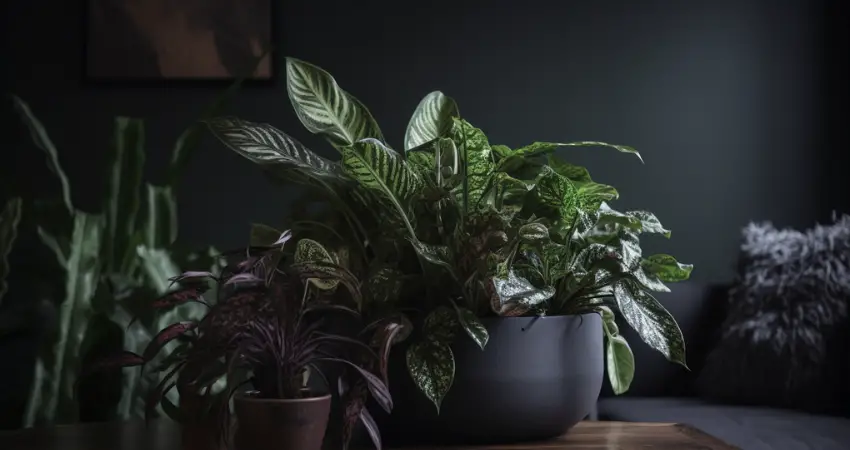
Several factors influence the humidity levels within your home, and understanding them can help you better control the environment for your plants.
1. Outdoor Climate and Weather
First and foremost, the climate and weather outside your home will impact your indoor humidity levels. High humidity outside can lead to increased indoor humidity, while drier outdoor conditions may cause your home’s humidity to drop.
2. Heating, Ventilation, and Air Conditioning (HVAC) Systems
Your HVAC system plays a vital role in managing your home’s humidity levels. In general, heating systems tend to lower indoor humidity, while air conditioning can both increase and decrease humidity, depending on the settings and system type.
3. Room Size and Air Circulation
Larger rooms and spaces with good air circulation can maintain higher humidity levels. Conversely, smaller rooms or those with limited air movement may struggle to maintain consistent humidity levels.
4. Presence of Other Plants and Water Sources
The presence of other plants and water sources in a room can also affect humidity. More plants and water sources can lead to increased humidity levels, while fewer plants and water sources may result in lower humidity.
Selecting Tropical Houseplants
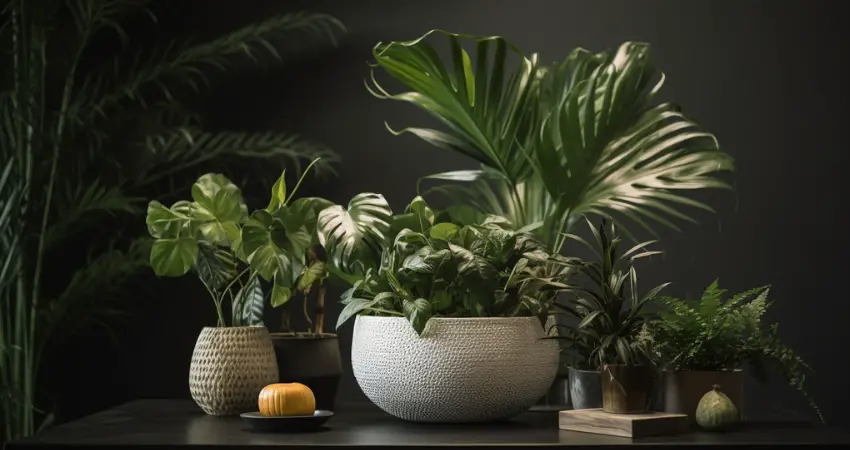
These houseplants are well-suited for most homes, as they are relatively easy to care for and can tolerate a wide range of humidity levels:
- Philodendron: With its glossy, heart-shaped leaves and trailing habit, philodendron is an excellent choice for a fast-growing indoor plant.
- Pothos: Similar to philodendron, pothos is a trailing plant with attractive foliage that can adapt to various humidity levels.
- Ferns: Tropical ferns are a popular choice for humid environments, with species like the Boston fern and maidenhair fern being among the easiest to care for.
- Alocasia: Sometimes referred to as “elephant ears,” alocasia plants boast large, showy leaves that make a statement in any home.
- Peperomia: With their compact growth habit and interesting leaf textures, peperomias are well-suited for smaller spaces.
- Bromeliad: Known for their vibrant, long-lasting blooms, bromeliads can bring a pop of color to your indoor space.
- Orchids: Although they have a reputation for being finicky, many orchid varieties are well-suited to indoor growing and can thrive with proper care.
When it comes to selecting tropical houseplants, consider the following popular species and their specific humidity requirements:
| Plant Species | Humidity Preference | Light Requirement | Temperature Range |
|---|---|---|---|
| Monstera deliciosa | 60-80% | Bright, indirect | 65-85°F (18-29°C) |
| Ficus elastica | 50-65% | Bright, indirect | 60-75°F (16-24°C) |
| Calathea | 60-80% | Low to medium | 65-75°F (18-24°C) |
| Philodendron | 60-75% | Medium to bright, indirect | 65-78°F (18-26°C) |
| Maranta | 60-80% | Low to medium | 60-80°F (16-27°C) |
| Pothos | 50 – 60% | Bright, indirect | 65 – 80°F |
| Ferns | 60 – 90% | Medium to bright, indirect | 60 – 75°F |
| Alocasia | 70 – 90% | Bright, indirect | 65 – 85°F |
| Peperomia | 50 – 60% | Bright, indirect | 65 – 75°F |
| Bromeliad | 50 – 70% | Bright, indirect | 60 – 85°F |
| Orchids | 40 – 70% | Bright, indirect | 60 – 85°F |
Remember, each species has unique requirements for light, temperature, and soil, in addition to humidity preferences. Understanding these needs will help you create the perfect environment for your tropical plants.
Methods to Increase Indoor Humidity
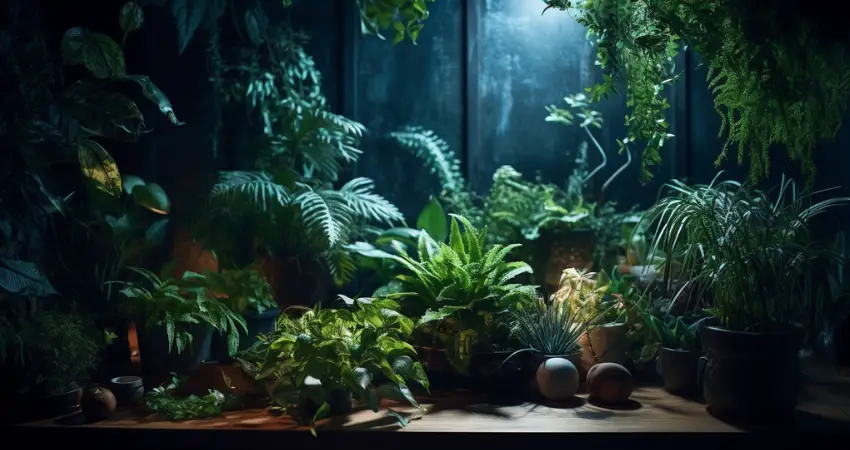
Creating a humidity-friendly environment for your tropical houseplants may require some adjustments to your indoor space. Here are some effective methods to increase humidity levels, along with detailed explanations to help you choose the most suitable approach for your home:
1. Grouping Plants Together
By placing plants close together, you create a microclimate that can increase humidity levels. As plants release moisture through transpiration, the moisture remains in the immediate area, benefiting neighboring plants.
When grouping plants, consider their individual light, temperature, and watering requirements to ensure compatibility. Also, be cautious about overcrowding, which can lead to poor air circulation and increase the risk of pests and diseases.
2. Using a Humidifier
A humidifier can be an excellent tool for increasing humidity levels. There are various types of humidifiers available, each with its own benefits and drawbacks:
- Ultrasonic humidifiers: These devices use high-frequency vibrations to create a fine mist, which increases the humidity level. They are energy-efficient, quiet, and typically have adjustable output levels. However, they may leave a white mineral dust residue if used with hard water, so it’s best to use distilled or filtered water.
- Evaporative humidifiers: This type of humidifier uses a fan to draw air through a wet wick or filter, which adds moisture to the air. They are self-regulating, meaning that they won’t over-humidify the room, and are generally low maintenance. However, they can be noisier than ultrasonic models and may require replacement filters.
- Warm mist humidifiers: Warm mist humidifiers create steam by heating water, which is then dispersed into the air. They can be effective in raising humidity levels, but may also increase room temperature. Additionally, they consume more energy and can be a burn risk due to the heating element.
Regardless of the type you choose, it’s essential to regularly clean and maintain the device to ensure optimal performance and prevent mold growth.
3. Creating a Humidity Tray
A humidity tray is a simple yet effective way to increase humidity around your plants. To create a humidity tray, follow these steps:
- Select a tray or shallow dish that is slightly larger than the base of your plant pot.
- Fill the tray with a layer of small stones, pebbles, or marbles.
- Add water to the tray, ensuring that the water level remains below the top of the stones.
- Place your plant pot on top of the stones, ensuring that the base does not come into direct contact with the water.
As the water evaporates, it will create a more humid environment around your plant.
4. Misting Plants with Water
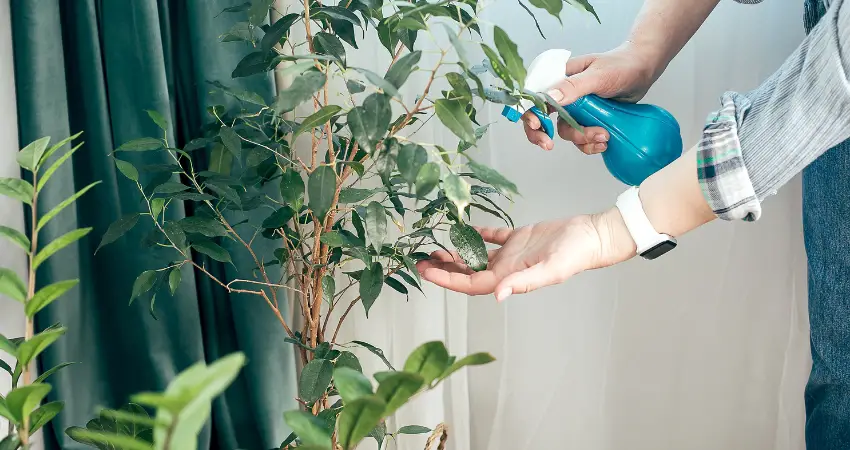
Misting your plants with water can help raise humidity levels temporarily. However, misting should be done cautiously, as excessive moisture on the leaves can lead to fungal issues. To mist effectively, follow these tips:
- Use a spray bottle with a fine mist setting.
- Mist your plants in the morning to allow the water to evaporate during the day, reducing the risk of fungal growth.
- Aim for the leaves’ undersides, as this is where the stomata (tiny openings responsible for gas exchange) are located.
5. Incorporating Water Features
Incorporating water features, such as small fountains or indoor ponds, can help increase humidity levels while adding visual interest to your space. The evaporating water will contribute to a more humid environment, benefiting your tropical plants. Be sure to clean and maintain your water features regularly to prevent algae growth and keep the water fresh.
6. Using a Moisture-Retaining Potting Mix
A moisture-retaining potting mix can help maintain higher humidity levels around your plants’ roots. Choose a mix that contains ingredients such as peat moss, coco coir, or vermiculite, which are known for their water retention properties. This will help ensure that your plants have access to consistent moisture, contributing to a more humid environment. Keep in mind that proper drainage is still essential, so be sure to include perlite or pumice to promote aeration and prevent root rot.
7. Ventilation and Air Circulation Management
Managing your home’s ventilation and air circulation can have a significant impact on humidity levels. Here are some tips to help you optimize these factors for your tropical plants:
- Avoid placing plants near vents or drafty areas: Exposure to forced air from vents or drafts can cause rapid moisture loss from your plants’ leaves, reducing humidity levels.
- Use ceiling fans or oscillating fans sparingly: While some air movement is beneficial for plant health, excessive use of fans can lower humidity levels. If using fans, ensure they are not directed straight at your plants.
- Open windows strategically: Opening windows can help increase humidity levels, especially during periods of high outdoor humidity. However, be mindful of outdoor temperature and humidity fluctuations, and adjust your window usage accordingly.
8. Setting Up a Humidity-Friendly Terrarium
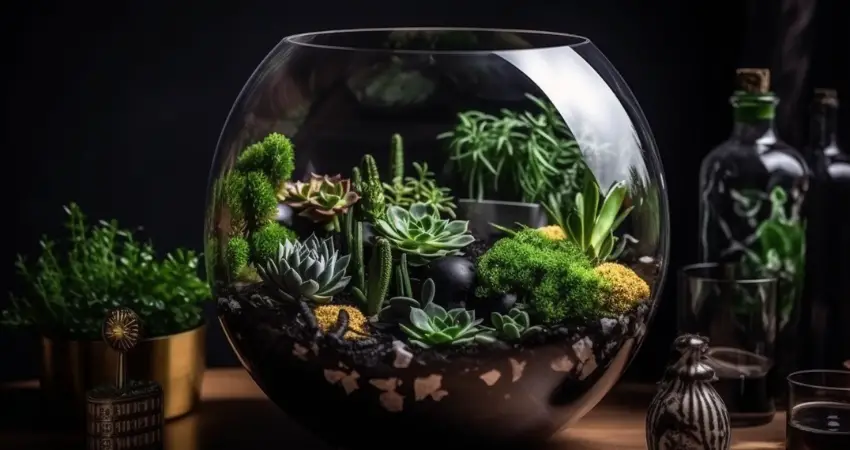
A terrarium is a fantastic way to provide a humidity-friendly environment for your tropical houseplants. You can easily create your own terrarium by following these steps:
- Select a suitable glass container with a large enough opening to fit your plants and materials.
- Create a drainage layer at the bottom of the container using a 2-inch layer of gravel or crushed stone. This is necessary because terrariums do not have drainage holes, and it prevents water from accumulating around plant roots (The Spruce).
- Add soil on top of the drainage layer, and then arrange your tropical plants, ensuring they are suited for the terrarium environment.
- Control the terrarium’s airflow and humidity using a lid or other means to keep the environment humid enough for the plants (Orchid Bliss).
- Adjust the light and temperature levels accordingly, ensuring the plants are comfortable in their new home.
- Water and fertilize as needed, observing the specific requirements for each plant type.
By setting up a humidity-friendly terrarium, you can effectively manage the humidity levels and create a moist environment that your tropical houseplants will love.
9. Using Cloches and Enclosed Planters
Aside from terrariums, another humidity-friendly solution for your tropical plants is using cloches and enclosed planters. Both these options offer distinctive advantages:
- Cloches: A cloche is a glass or plastic dome placed over a potted plant to keep the humidity levels high. When the sun hits the glass, it creates steamy conditions that tropical plants will thrive in. However, it is essential to avoid direct sunlight, as it becomes magnified by the cloche and can cause the temperature to rise too fast, scorching the plants (Apartment Therapy).
- Enclosed Planters: These planters have integrated humidity trays or pebble trays that retain water and gradually release moisture into the surroundings. By placing your tropical plants in enclosed planters, you maintain a stable humidity level and provide a damp environment that supports their growth.
Incorporating terrariums, cloches, and enclosed planters into your home not only elevates the beauty of your space but also maintains the ideal humidity levels and damp environment for your tropical houseplants to flourish.
Monitoring and Adjusting Humidity Levels
Regular monitoring and adjusting of humidity levels are crucial to ensure a healthy environment for your tropical houseplants.
Importance of Regular Monitoring
By monitoring humidity levels, you can identify and address potential problems before they impact your plants. Frequent monitoring also allows you to adjust your humidity control methods as needed, ensuring that your plants receive the optimal level of moisture.
Tools for Measuring Humidity
There are several tools available to help you measure humidity levels:
- Hygrometer: A hygrometer is an instrument specifically designed to measure humidity. They come in both analog and digital forms and can provide accurate measurements of relative humidity.
- Smart home devices: Some smart home devices, such as smart thermostats or indoor air quality monitors, have built-in sensors that measure humidity levels. These devices can provide real-time data and may even offer alerts or recommendations based on the readings.
Interpreting Humidity Measurements
When interpreting humidity measurements, keep in mind the ideal humidity range for your specific tropical houseplants. If your readings are consistently outside of this range, consider implementing additional humidity control methods or adjusting your existing strategies.
Adjusting Humidity Levels Based on Plant Needs
As you monitor humidity levels, be prepared to adjust your methods and techniques to suit your plants’ needs. This may include adding or removing water sources, adjusting your HVAC settings, or changing the placement of your plants within your home. Remember that your plants’ humidity requirements may change over time or with seasonal fluctuations, so be prepared to adapt accordingly.
Identifying and Addressing Humidity-Related Issues
Understanding the signs of humidity-related stress in your tropical houseplants can help you address issues before they become more severe.
Signs of Low Humidity Stress
- Brown leaf tips: Dry, brown leaf tips can indicate insufficient humidity levels. This is particularly common in plants with thinner leaves, such as ferns and Calatheas.
- Wilting: Even with adequate watering, plants can still wilt if the air is too dry, as moisture is lost through transpiration more rapidly than it can be replaced.
- Yellowing leaves: Leaves may turn yellow and dry out due to low humidity, especially if the issue persists for an extended period.
Signs of High Humidity Stress
- Mold and mildew growth: Excess humidity can create a conducive environment for mold and mildew growth on plant leaves, soil, and surrounding surfaces.
- Root rot: Overly moist conditions may lead to root rot, which is caused by fungal pathogens that thrive in wet, oxygen-deprived environments.
- Pest infestations: High humidity can also attract pests such as fungus gnats, spider mites, and mealybugs, which can damage your plants and spread diseases.
Troubleshooting and Resolving Humidity-Related Problems
When you notice any of these symptoms, take action to address the underlying humidity issue:
- Adjust your humidity control methods, such as using a humidifier or creating a humidity tray, to achieve the appropriate humidity levels.
- Ensure proper air circulation to prevent excessive humidity buildup and discourage mold, mildew, and pest infestations.
- Monitor your plants closely for any changes in their condition and adjust your care routine accordingly.
Maintenance and Care for Tropical Houseplants
Proper maintenance and care are essential for keeping your tropical houseplants healthy and thriving.
Regular Watering and Fertilizing
- Watering: Tropical houseplants typically require consistent moisture. Water your plants when the top inch of soil feels dry to the touch, using room-temperature water. Be sure to avoid over-watering, which can lead to root rot.
- Fertilizing: Most tropical plants benefit from regular fertilization, especially during the growing season. Use a balanced, water-soluble fertilizer diluted to half strength, and follow the package instructions for application frequency.
Pruning and Shaping
Prune your tropical houseplants to maintain their shape and encourage bushier growth. Remove dead or damaged leaves, and trim back leggy stems to promote branching.
Pest Control and Prevention
Inspect your plants regularly for signs of pests, such as sticky residue, webbing, or discolored leaves. If you notice any pests, treat the plant promptly with insecticidal soap or a suitable pesticide, and isolate the affected plant to prevent the pests from spreading.
Seasonal Care and Adjustments
As the seasons change, your tropical houseplants may require adjustments to their care routine:
- Light: During the darker winter months, consider supplementing natural light with artificial grow lights to maintain healthy growth.
- Temperature: Ensure that your plants are not exposed to cold drafts or sudden temperature fluctuations, which can cause stress and damage.
- Watering and fertilizing: In the winter, your plants may require less frequent watering and fertilizing, as their growth may slow down during this time. Adjust your care routine accordingly to avoid over-watering and nutrient imbalances.
Bottom Line
Creating a humidity-friendly environment for your tropical houseplants may require some time and effort, but the results are well worth it. By understanding the factors that affect indoor humidity and implementing effective strategies to control it, you can ensure that your tropical plants flourish in your home. Don’t be afraid to experiment and adapt your techniques to suit your specific needs – your plants will thank you for it!
